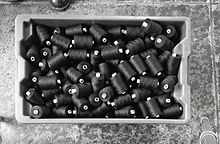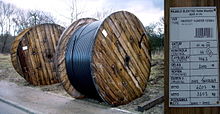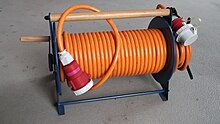Reel
A reel or reel is an element made of cardboard , wood , plastic or steel , onto which material with a round cross-section such as yarn , rope , wire , cable or tape -like material such as magnetic tape , film and paper is wound. Both the core and the core including the material wound around it are referred to as the coil.
In contrast to a reel , which is also used to wind up various materials, a reel is not an independent device or technical aid, but only an interchangeable component of a device (e.g. spinning wheel or camera), a disposable item that only Transport, distribution and further use, or an integral part of a component (coil formers of chokes and transformers ).
The following forms can be distinguished:
- Disc reel (cylindrical and with protruding borders on the end faces)
- cylindrical spool or reel
- conical coil.
Dye spools made of V4A stainless steel or plastic are perforated so that the yarns wound on them can be dyed with the spool.
Spools in the textile sector
Spools - including sleeves - in the sense of DIN 61805 are used to wind up threads and can consist of hard paper, cardboard, wood, plastic or aluminum; the spool with the wound material is also referred to as a spool and is regulated in DIN 61800 . They are either tubular or also have side windows on both sides (disk coils). No side washers are required when the yarn is criss-crossed , these so-called cross-wound bobbins are regulated in DIN 61801 .
be crazy
Spinning-wheel bobbins are always disc bobbins, mostly made of wood. In industrial spinning mills, so-called cylindrical cops are used as yarn tubes onto which the spun thread is wound.
Weave
Weaving yarns are usually made up in the form of cylindrical or conical packages, which are wound on a core made of hard cardboard or plastic. The cylindrical shapes up to 250 g are mainly used in hand weaving, large cones weighing 1–2 kg in industrial weaving. In the house weaving mill, reusable warp bobbins were also used as disc bobbins made of wood, onto which other carriers (cross bobbins or strands) were rewound. Thin, cylindrical thread tubes made of cardboard are used for self- wound weft bobbins .
sew
Sewing thread is sold both as a cylindrical (for commercial use also conical) package and as a disc bobbin. In sewing machines, steel or plastic disc bobbins are used for the bobbin thread.
Embroider
The bobbin is the sleeveless, coil-shaped wound thread reservoir in an embroidery shuttle .
Other uses
Photo and sound technology
- Tape reels for tape recorders and magnetic tapes
- Film reels for film cameras and projectors , in particular plug-in reels as a special design
- Film rolls for cameras
Sanitary area
- Simple rolls mostly made of cardboard, e.g. for toilet or kitchen paper
Cable drum
- Industrially used cable drums or reels (also called tourets ), from hand-sized (e.g. plastic drums for wire) to drums with a diameter of several meters that have to be transported on their own low-loaders. The latter are used in particular for laying cables.
- Cable drum or cable reel (also called "cable reel" in Switzerland and Austria)
For cable drums in the general understanding of speech, it is actually cable reel according to DIN VDE 620 part 300 or DIN VDE 623 part 100. In the in private or craft area as extension cable used for electrical connections cable rollers (also coiler called) is an additional hand crank mounted for winding and one or more sockets built into the drum .
It should be noted that the maximum power that the connected devices can have together is lower with a rolled up drum than with an unrolled cable, since the heat dissipation is more difficult with a wound cable compared to an unrolled one. This makes it much easier for heat build-up, overheating, burnout and cable fire to occur. Therefore, cable drums should always be completely unrolled before use.
Modern cable drums are usually equipped with an overtemperature protection device that interrupts the flow of current in the event of overheating. However, the presence of such a fuse and its correct function are not always readily apparent. If the overtemperature protection has triggered, all plugs must be pulled out immediately , both those of the cable drum and those of the connected devices. Furthermore, the cable should be completely unrolled so that the cable can cool down. It should also be borne in mind that with some cable drums the overtemperature protection resets automatically after cooling, which enables current to flow again. Since all connected devices can then start up again, which can be very dangerous for devices with electrically moving parts (e.g. drill , circular saw ), it is very important to pull the plug. Higher-quality cable drums are equipped with an excess temperature protection, which must be reset manually at the push of a button after it has been triggered and cooled down.
On higher-quality cable drums, there is information on the maximum total power up to which devices may be connected with a fully or partially rolled up and with a completely unrolled cable drum.
Individual evidence
- ↑ Alois Kießling, Max Matthes: Textile specialist dictionary . Schiele & Schön Fachbuchverlag, Berlin 1992, ISBN 3-7949-0546-6 , keywords spool , spools






